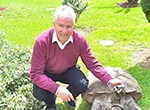 Most of us end up with a handful of people who remember us. Teachers have thousands of people who remember them for the rest of their lives. I’ve been lucky to have had dozens of memorable teachers, and one of the first was Miss Molineux. Miss Molineux was young, enthusiastic, and kind. We were not just the seven year olds she taught, but her devoted fan club. She drilled us in multiplication, encouraged our developing reading, and stayed late to play cricket with us after school. To this day if I have to multiply 8 by 7, a whiff of Miss Molineux’s perfume and 56 are simultaneous events.
Most of us end up with a handful of people who remember us. Teachers have thousands of people who remember them for the rest of their lives. I’ve been lucky to have had dozens of memorable teachers, and one of the first was Miss Molineux. Miss Molineux was young, enthusiastic, and kind. We were not just the seven year olds she taught, but her devoted fan club. She drilled us in multiplication, encouraged our developing reading, and stayed late to play cricket with us after school. To this day if I have to multiply 8 by 7, a whiff of Miss Molineux’s perfume and 56 are simultaneous events.
Thirty years later I found myself teaching sums to would-be GPs. MRCGP exam candidates badly needed some remedial teaching in the basics of clinical epidemiology. It was, I’m afraid, classic pre-exam cramming with course attenders taking home a folder as “a living monument to temporary knowledge.” Pretty quickly I became aware that teaching and learning numbers was a tricky business for both parties.
A small study found about 5% of US medial students scored zero or one when faced with three simple sums. When information on treatment choices was presented in different ways (relative risk reduction, absolute risk reduction, etc.) only 60% could provide a quantitative answer. Being able to do simple sums and simple clinical epidemiology were linked. I reckon it’s at least 5% who struggle, and there are a few kind, intelligent, and hardworking doctors out there coping with unrecognised, but serious dyscalculia. Of course, numeracy is a two-way street. About 70% patients scored zero or one on the same simple sums, and patients with poor numeracy skills have significantly worse anticoagulant control.
Sometimes, perhaps a few times a week, we need some numbers. Anticoagulation reduces the relative risk of stroke by 60% in atrial fibrillation. That’s impressive; most people would love to reduce their risk of a really bad thing happening by over half. But someone with AF and a Cha2DS2-VASc score of 3 has about a 3% annual absolute risk of stroke. So if a 1000 people with a Cha2DS2-VASc score of 3 don’t take anticoagulation, in a year 30 of them have a stroke, but 970 don’t. If we anticoagulate all 1000 people, 18 of the 30 people who would have a stroke don’t, but there are still 12 people who have strokes despite anticoagulation. Without a crystal ball, we can’t predict whether the patient in front of us will be one of the 970 who would be fine without treatment, would be one of the 18 we help, or one of the 12 who we try and help but don’t.
Based on my experience, developing the skills to optimally convey risks and benefits using natural frequencies is a minority sport. Visual depictions can help this, but it’s not an intuitive skill for most people. Shared decision making looks like another social movement, but I fear lots of us need the fragrant Miss Molineux and her times tables to make a comeback.
Competing interests: I declare that I have read and understood the BMJ Group policy on declaration of interests and I hereby declare the following interests: Employed part time by the National Institute of Health and Care Excellence.
Neal Maskrey‘s early career was as a GP before spending seven years as a medical manager and part time GP. After twelve years as a director of the National Prescribing Centre and programme director at NICE, he is now honorary professor of evidence-informed decision making at Keele University, and consultant clinical adviser in the Medicines and Prescribing Centre, NICE.
